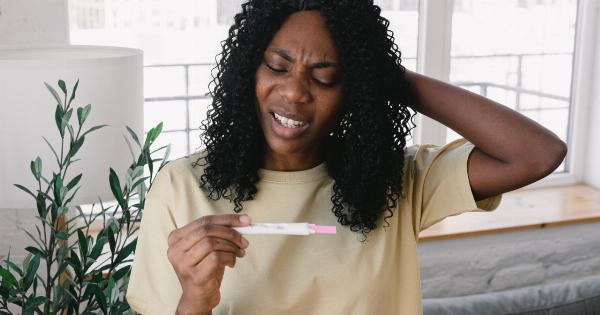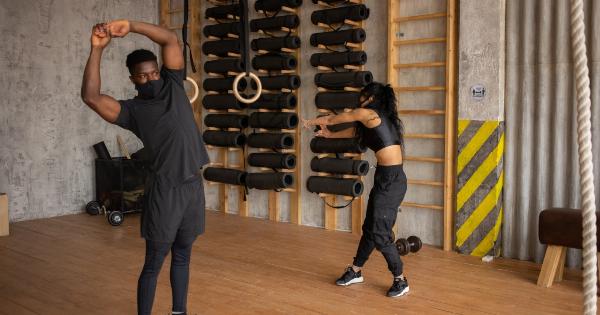Pregnancy comes with a myriad of changes to a woman’s body. While most of these changes are necessary and expected, some can cause discomfort and even pain. One such common discomfort experienced by pregnant women is hemorrhoids.
Hemorrhoids, also known as piles, are swollen blood vessels in the rectal area. They can be quite uncomfortable and often cause itching, pain, and bleeding. In this article, we will explore why hemorrhoids happen during pregnancy and discuss some tips on how to manage and prevent them.
1. Increased pressure
During pregnancy, the growing uterus puts increased pressure on the pelvic veins, including those in the rectal area. This pressure can lead to the development of hemorrhoids.
As the pregnancy progresses, the weight of the baby further adds to this pressure, causing veins to stretch and swell.
2. Hormonal changes
Pregnancy hormones, such as progesterone, play a crucial role in relaxing the walls of blood vessels to allow increased blood flow to the developing fetus. However, these hormonal changes can also affect the veins in the rectal area.
The relaxation of these blood vessels can make them more susceptible to swelling and inflammation, leading to hemorrhoids.
3. Constipation
Constipation is a common problem during pregnancy due to hormonal changes, pressure from the growing uterus, and iron supplements. Straining during bowel movements can put additional pressure on the rectal area, causing hemorrhoids to form or worsen.
4. Increased blood volume
During pregnancy, a woman’s blood volume increases significantly to support the needs of the developing fetus. This increased blood volume can cause the veins to become dilated and swollen, making them more prone to developing hemorrhoids.
5. Lack of physical activity
Pregnant women often find it challenging to engage in regular physical exercise due to the added weight and physical discomfort. Lack of physical activity can lead to poor blood circulation, making it easier for hemorrhoids to form.
6. Genetics
Some women may be genetically predisposed to developing hemorrhoids during pregnancy. If there is a family history of hemorrhoids, the likelihood of experiencing them during pregnancy may be higher.
7. Straining during labor
During the pushing stage of labor, the intense pressure exerted on the rectal area can cause existing hemorrhoids to become more swollen and painful. This is often temporary, and the hemorrhoids may shrink back to their original size postpartum.
Managing and preventing hemorrhoids during pregnancy
While hemorrhoids during pregnancy can be uncomfortable, there are several steps you can take to manage and prevent them:.
1. Maintain good hygiene
Keep the rectal area clean by gently washing with warm water and mild soap. Avoid harsh wiping or using scented toilet paper, as these can irritate the area further.
2. Increase fiber intake
Consuming a diet rich in fiber can help prevent constipation, making it easier to pass stools. Include foods such as whole grains, fruits, vegetables, and legumes in your meals. Additionally, drink plenty of water to stay hydrated.
3. Practice good bathroom habits
Avoid straining during bowel movements and take your time on the toilet. If needed, use a stool to elevate your feet, which can help in achieving a more natural squatting position.
4. Stay physically active
Engaging in regular exercise can help improve blood circulation and prevent constipation. Consider low-impact activities such as walking, swimming, or prenatal yoga.
5. Use over-the-counter remedies with caution
Some over-the-counter treatments may provide temporary relief from hemorrhoid symptoms. However, always consult with your healthcare provider before using any medications or creams, especially during pregnancy.
6. Apply cold compress or witch hazel pads
Placing a cold compress or using witch hazel pads can provide temporary relief from itching and swelling. However, refrain from using creams or wipes containing steroids unless prescribed by a healthcare professional.
7. Avoid sitting or standing for prolonged periods
Taking frequent breaks from sitting or standing can help alleviate pressure on the rectal area. Try to change positions and move around regularly throughout the day.
8. Use a cushion or donut-shaped pillow
If you find sitting uncomfortable due to hemorrhoids, consider using a cushion or donut-shaped pillow to relieve pressure on the affected area.
9. Practice Kegel exercises
Kegel exercises can strengthen the pelvic floor muscles and improve blood circulation in the rectal area. Consult with a healthcare provider or a physical therapist to learn the proper technique for Kegel exercises.
10. Seek medical advice
If your hemorrhoids persist or cause severe pain and bleeding, it is important to seek medical advice. Your healthcare provider can provide further guidance and recommend suitable treatment options to alleviate your symptoms.































